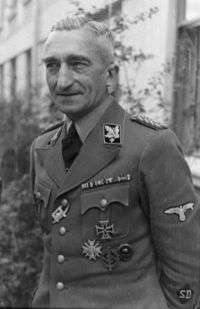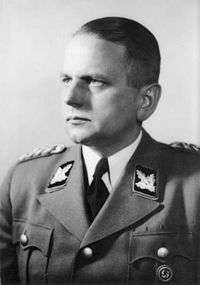List of Einsatzgruppen
Einsatzgruppen (German for "task forces",[1] "deployment groups";[2] singular Einsatzgruppe; official full name Einsatzgruppen der Sicherheitspolizei und des SD) were Schutzstaffel (SS) paramilitary death squads of Nazi Germany that were responsible for mass killings, primarily by shooting, during World War II. The Einsatzgruppen had a leading role in the implementation of the Final Solution of the Jewish question (Die Endlösung der Judenfrage) in territories conquered by Nazi Germany.
Under the direction of Reichsführer-SS Heinrich Himmler and the supervision of SS-Obergruppenführer Reinhard Heydrich, the Einsatzgruppen operated in territories occupied by the German armed forces following the invasion of Poland in September 1939 and Operation Barbarossa (the invasion of the Soviet Union) in June 1941. Historian Raul Hilberg estimates that between 1941 and 1945 the Einsatzgruppen and related auxiliary troops killed more than two million people, including 1.3 million Jews.[3] The total number of Jews murdered during the Holocaust is estimated at 5.5 to six million people.[4]
After the close of the World War II, 24 senior leaders of the Einsatzgruppen were prosecuted in the Einsatzgruppen Trial in 1947–48, charged with crimes against humanity and war crimes. Fourteen death sentences and two life sentences were among the judgments. Four additional Einsatzgruppe leaders were later tried and executed by other nations.[5]
Invasion of Poland
Seven Einsatzgruppen of battalion strength operated in Poland. Each was subdivided into four Einsatzkommandos of company strength.[6]
- Einsatzgruppe I, commanded by SS-Standartenführer Bruno Streckenbach, acted with 14th Army
- Einsatzgruppe II, SS-Obersturmbannführer Emanuel Schäfer, acted with 10th Army
- Einsatzgruppe III, SS-Obersturmbannführer und Regierungsrat Dr. Herbert Fischer, acted with 8th Army
- Einsatzgruppe IV, SS-Brigadeführer Lothar Beutel, acted with 4th Army
- Einsatzgruppe V, SS-Standartenfürer Ernst Damzog, acted with 3rd Army
- Einsatzgruppe VI, SS-Oberführer Erich Naumann, acted in Wielkopolska
- Einsatzgruppe VII, SS-Obergruppenführer Udo von Woyrsch and SS-Gruppenführer Otto Rasch, acted in Upper Silesia and Cieszyn Silesia[6]
Invasion of the Soviet Union and other countries
| Einsatzgruppe | Leader | Subgroups | |
|---|---|---|---|
| Einsatzgruppe A (Baltic states)[7] |
SS-Brigadeführer Dr. Franz Walter Stahlecker (until 23 March 1942) |
 |
|
| Einsatzgruppe B (Belarus)[7] |
SS-Brigadeführer Arthur Nebe (until October 1941) |
 |
|
| Einsatzgruppe C (Northern and central Ukraine)[7] |
SS-Gruppenführer Dr. Otto Rasch (until October 1941) |
 |
|
| Einsatzgruppe D (Bessarabia, Southern Ukraine, Crimea, and Caucasus)[7] |
SS-Gruppenführer Prof. Otto Ohlendorf (until June 1942) |
 |
|
| Einsatzgruppe E (Croatia)[8] |
SS-Obersturmbannführer Ludwig Teichmann, SS-Standartenführer Günther Herrmann, SS-Standartenführer Wilhelm Fuchs | Five Einsatzkommandos located in Vinkovci, Sarajevo, Banja Luka, Knin, and Zagreb | |
| Einsatzgruppe F (Army Group South)[9] |
|||
| Einsatzgruppe G (Romania, Hungary, Ukraine)[8] |
SS-Standartenführer Dr. Josef Kreuzer | Einsatzkommandos 11 and 12 | |
| Einsatzgruppe H (Slovakia)[10] |
|||
| Einsatzgruppe K (with 5th Panzer Army in the Ardennes offensive)[11] |
SS-Oberführer Dr. Emanuel Schäfer | ||
| Einsatzgruppe L (with 6th Panzer Army in the Ardennes offensive)[11] |
SS-Standartenführer Dr. Ludwig Hahn | ||
| Einsatzgruppe Griechenland (Greece)[12] | SS-Sturmbannführer Dr. Ludwig Hahn | ||
| Einsatzgruppe Iltis (Carinthia (Slovenia))[13] | SS-Standartenführer Paul Blobel | ||
| Einsatzkommando Luxemburg (Luxembourg)[9] | |||
| Einsatzgruppe Norwegen (Norway)[14] | SS-Oberführer Dr. Franz Walter Stahlecker | ||
| Einsatzgruppe Serbien (Yugoslavia)[15] | SS-Standartenführer Wilhelm Fuchs, SS-Gruppenführer August Meysner | ||
| Einsatzgruppe for Special Purposes (eastern Poland)[7] |
SS-Brigadeführer und Generalmajor der Polizei Karl Eberhard Schöngarth |
||
| Einsatzkommando Tilsit (Lithuania, Poland)[16] | |||
| Einsatzgruppe Tunis (Tunis)[17] | SS-Obersturmbannführer Walter Rauff | ||
| Proposed Einsatzgruppe (United Kingdom)[18] |
SS-Standartenführer Dr. Franz Six |
 |
|
| Proposed Einsatzgruppe (Middle East)[19] |
SS-Obersturmbannführer Walter Rauff |
| |
References
- ↑ LEO Dictionary.
- ↑ Encyclopaedia Britannica.
- ↑ Rhodes 2002, p. 257.
- ↑ Evans 2008, p. 318.
- ↑ Rhodes 2002, pp. 274–275.
- 1 2 Weale 2010, p. 225.
- 1 2 3 4 5 Rhodes 2002, p. 12.
- 1 2 MacLean 1999, p. 23.
- 1 2 Museum of Tolerance.
- ↑ Longerich 2010, p. 419.
- 1 2 Dams & Stolle 2012, p. 168.
- ↑ Conze, Frei et al. 2010.
- ↑ Crowe 2007, p. 267.
- ↑ Larsen 2008, p. xi.
- ↑ Shelach 1989, p. 1169.
- ↑ Longerich 2010, p. 197.
- ↑ Mallmann, Cüppers & Smith 2010, p. 130.
- ↑ Shirer 1960, p. 783.
- ↑ Weale 2010, p. 386.
Bibliography
- "Book review: Tasks of the Einsatsgruppen by Alfred Streim". Museum of Tolerance Online Multimedia Learning Center, Annual 4, Chapter 9. Los Angeles: Simon Wiesenthal Center. Retrieved 6 May 2013.
- Conze, Eckart; Frei, Norbert; Hayes, Peter; Zimmermann, Moshe (2010). Das Amt und die Vergangenheit : deutsche Diplomaten im Dritten Reich und in der Bundesrepublik (in German). Munich: Karl Blessing. ISBN 978-3-89667-430-2.
- Crowe, David (2007) [2004]. Oskar Schindler: The Untold Account of his Life, Wartime Activities and the True Story Behind the List. New York: Basic Books. ISBN 978-0-465-00253-5.
- Dams, Carsten; Stolle, Michael (2012) [2008]. Die Gestapo: Herrschaft und Terror im Dritten Reich. Becksche Reihe (in German). Munich: Beck. ISBN 978-3-406-62898-6.
- Evans, Richard J. (2008). The Third Reich at War. New York: Penguin Group. ISBN 978-0-14-311671-4.
- "Reflections on the Holocaust: "The Einsatzgruppen"". Encyclopaedia Britannica. Retrieved 10 January 2013.
- Larsen, Stein Ugelvik (2008). Meldungen aus Norwegen 1940-1945: Die geheimen Lagesberichte des Befehlshabers der Sicherheitspolizei und des SD in Norwegen, 1 (in German). Munich: Oldenburg. ISBN 978-3-486-55891-3.
- LEO Dictionary Team. "LEO Deutsch-Englisches Wörterbuch "einsatzgruppe"" (in German). Dict.leo.org. Retrieved 10 January 2013.
- Longerich, Peter (2010). Holocaust: The Nazi Persecution and Murder of the Jews. Oxford; New York: Oxford University Press. ISBN 978-0-19-280436-5.
- MacLean, French L. (1999). The Field Men: The SS Officers Who Led the Einsatzkommandos—The Nazi Mobile Killing Units. Schiffer Military History. Madison, WI: Schiffer. ISBN 978-0-7643-0754-6.
- Mallmann, Klaus-Michael; Cüppers, Martin; Smith, Krista (2010). Nazi Palestine: The Plans for the Extermination of the Jews in Palestine. New York: Enigma. ISBN 1-929631-93-6.
- Rhodes, Richard (2002). Masters of Death: The SS-Einsatzgruppen and the Invention of the Holocaust. New York: Vintage Books. ISBN 0-375-70822-7.
- Shelach, Menachem (1989). "Sajmište: An Extermination Camp in Serbia". In Marrus, Michael Robert. The Victims of the Holocaust: Historical Articles on the Destruction of European Jews. 2. Westport, CT: Meckler.
- Shirer, William L. (1960). The Rise and Fall of the Third Reich. New York: Simon & Schuster. ISBN 978-0-671-62420-0.
- Weale, Adrian (2010). Army of Evil: A History of the SS. New York; Toronto: Penguin Group. ISBN 978-0-451-23791-0.